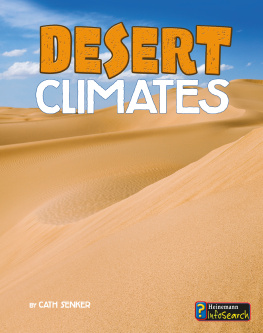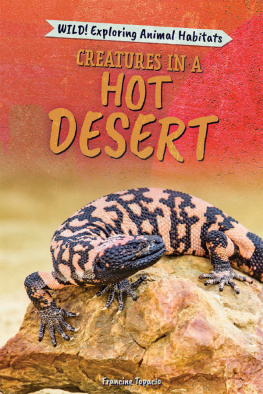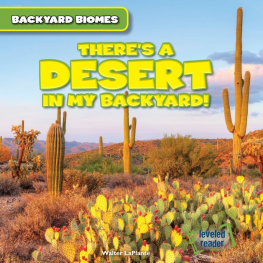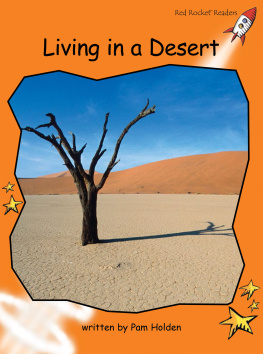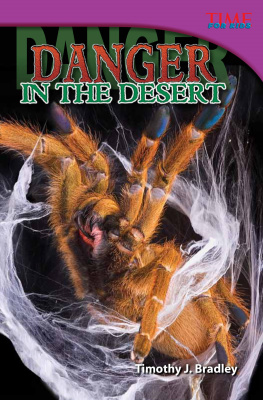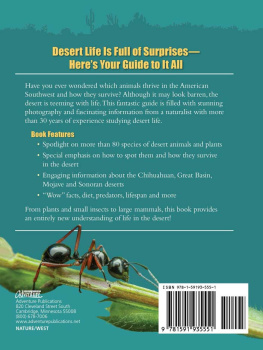
D is for Desert
A World Deserts Alphabet
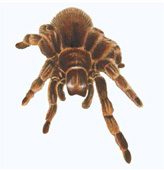
Written by Barbara Gowan
Illustrated by Gijsbert van Frankenhuyzen
A
Around one-third of the land surface of Planet Earth is desert. Deserts may be covered in dust, stones, or snow. They may be oceans of sand or rivers of ice, mountain peaks, sand dunes, or rocky plains. All deserts share one characteristic: there is little water available. A desert receives less than 10 inches (25 centimeters) of rain a year, and most of it comes in the form of violent storms. Because desert air is so dry and the suns rays are so strong, any water evaporates quickly. Deserts like the Sahara in northern Africa and the Thar in India and Pakistan have daytime temperatures so high that an egg can fry on the sand.
Not all deserts are hot. Cold deserts like the Gobi in China and Mongolia and the Patagonian Desert in Argentina are more frigid than a freezer. Fog and snow bring moisture to cold deserts. The land near the North and South Poles is a desert because nearly all the water is locked up in sheets of ice.
The cold Atacama in South America is the most arid desert in the world. Rain rarely falls, but fog rolls in from the sea. Coastal residents harvest the fog by catching the mist on nets. The moisture drips into a trough and then is piped into the village, providing water for these desert dwellers.
Arid begins with the letter A .
Its a word that means very dry. For 400 years in the Atacama Desert, no rain fell from the sky.

B
The Bactrian camel can live without food for months at a time. The camel stores fat in its two humps. This fat can be converted to energy when food is scarce. The humps lean and droop on a hungry camel. When thirsty, the camel soaks up water like a sponge, drinking 30 gallons (114 liters) in only 13 minutes.
This animal is well adapted for life in the harsh, rocky, and cold deserts of Mongolia and China. Its shaggy winter coat of thick hair and underwool insulates it against the frigid nights, when temperatures can drop to -29 Fahrenheit (-34 Celsius). Large chunks of fur are quickly shed in the summer as the desert heat soars to over 100F (38C). Long, silky eyelashes, see-through third eyelids, bushy eyebrows, ears lined with fur, and nostrils that can be pinched shut protect the camel during a sandstorm. This well-designed pack animal is capable of carrying heavy loads. Wide, flat footpads help it traverse the rocky terrain.
There are many domestic camels, but the wild Bactrian camel is an endangered species with fewer than 1,000 individuals alive today.
B is for the Bactrian camel.
It has two humps to store rich fat that provides energy when plants are scarce in its rocky desert habitat.
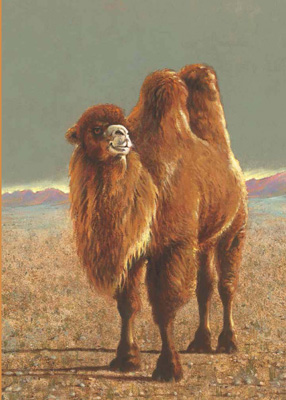
C
The word cactus comes from the Greek word kaktos, which means spiny plant. Cactus spines can be stiff, papery, wooly, curved, or needlelike. From being so small that they are almost invisible to being as long as a pencil, cactus spines are colored white, yellow, brown, black, or red. Bands of colored spines line up around the stem of the rainbow hedgehog cactus.
If a cactus had leaves, it would lose too much moisture in the drying desert winds. Spines are modified leaves and a way to conserve water. Hairy spines provide shade from the intense rays of the sun. At night they trap dew, which dribbles down to the roots. Spiky spines discourage most hungry animals. The jumping cholla (CHOY-ah) relies on its barb-tipped spines to stick to passing animals. The hitchhiking cactus eventually gets knocked off, takes root, and grows a new plant.
A cactus is called a succulent. It stores water in its pads and stem. The pleated shape of the barrel cactus allows it to expand when it rains and store water like a sponge. Its waxy skin seals in moisture. The hot Chihuahuan Desert in north central Mexico and southwestern United States is home to 350 species, one-fifth of all the worlds known cacti.
Cactus begins with the letter C .
This desert plant with a waxy skin is protected by spines as sharp as a pin.
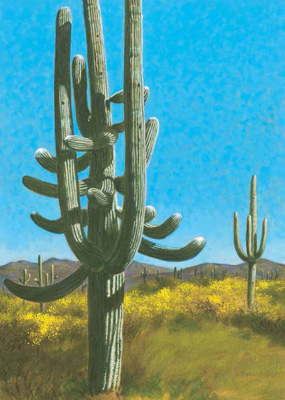
D
Welcome to Furnace Creek in Death Valley National Park, the hottest and driest place in North America. Here, air temperatures reach over 100 Fahrenheit (38 Celsius) for four consecutive months. The desert floor can be even 40 degrees hotter. Annual rainfall averages less than 2 inches (5 centimeters) in this Mojave Desert park, and there have been some years with no recorded rain.
Death Valley lies in a long, narrow basin walled in by steep mountain ranges. The sun heats the desert soil and rocks, and the hot air becomes trapped in the valley.
Badwater Basin, the lowest place in North America, lies 282 feet (86 meters) below sea level. Shallow pools filled with minerals dissolved from rocks form here after flash floods. Because of the arid climate, water evaporates quickly, leaving a salt flat coated with a crust of sparkling white salt crystals.
Park visitors can explore dry waterfalls in marble canyons, snow-capped mountain peaks, sand dunes, volcanic craters, and the Devils Golf Course, where jagged spires of rock salt cover the ground.
D is for Death Valley, a place of scorching heat. Here the sun bakes the land as dry and hard as concrete.
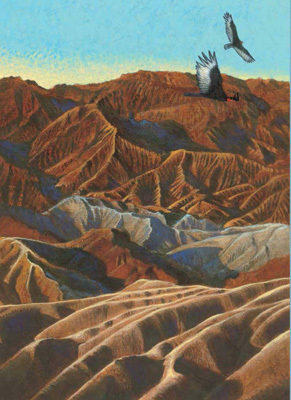
E
An erg looks like a sea of sand. It may have dunes as tall as skyscrapers or vast plains of sand (called sand sheets).
Sandstorms driven by fierce winds shape an erg. When a shrub or boulder gets in the path of the windblown sand, a dune can form. Over time, sand piles up into a huge mound. If the wind gusts from only one direction, a barchan (a dune shaped like a crescent moon) forms. A star dune results from wind blowing from many directions. A long ridge with a swordlike crest is a seif dune and can extend for over 120 miles (193 kilometers). Large ergs, or sand seas, have taken shape over one million years and can be easily seen from satellites in space.
The largest erg in the world is located on the Arabian Peninsula. Rub al-Khali (the empty quarter) is the size of Texas and extends into four countriesSaudi Arabia, Oman, Yemen, and the United Arab Emirates. Beneath this vast sea of sand lie enormous quantities of the worlds major energy source, oil.
E is for Erg, a sea of sand grains stretching for hundreds of miles on a flat, wind-swept terrain.
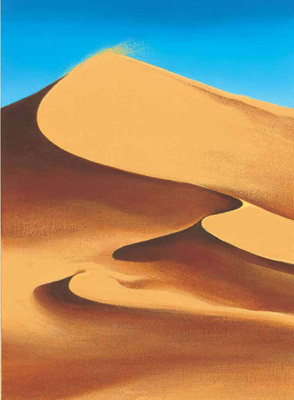
F
Dark storm clouds build up in the sky. Lightning flashes and thunder cracks. Huge raindrops develop into a torrential downpour. The summer monsoon has arrived in the desert southwest of the United States. The rain falls so hard and so fast that the parched earth cannot soak up all the water. The runoff flows like a raging river into a channel called a dry wash, or arroyo.
Next page

